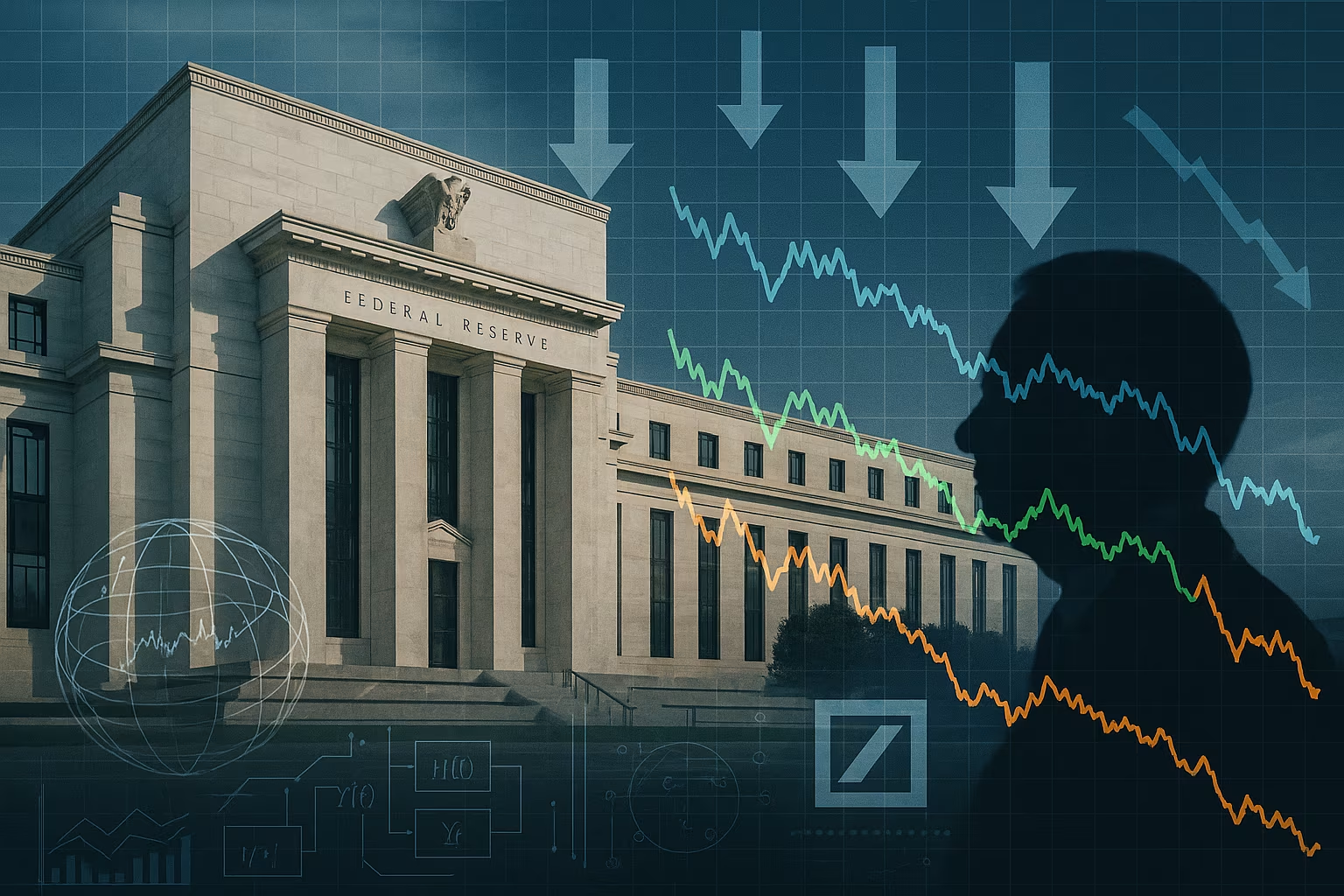The debate over U.S. monetary policy has taken a dramatic turn after Treasury Secretary Scott Bessent’s call for a deep interest rate cut in September. His view, suggesting the Federal Reserve should deliver a half-point reduction and potentially launch a broader easing cycle, stands in sharp contrast to traditional Fed modeling and major institutional forecasts, including those from Deutsche Bank. This clash highlights the growing uncertainty around the central bank’s path and raises questions about how policymakers will balance economic risks against credibility.
A Half-Point Cut Proposal That Shook Markets
Scott Bessent recently argued that the Federal Reserve should cut interest rates by as much as 50 basis points in September, a move that would go beyond the market’s already dovish expectations. According to him, the economy is facing enough downside risks to warrant faster and bolder monetary easing, rather than incremental adjustments. He even hinted that this could be the beginning of a cycle totaling 150 to 175 basis points in cuts over the coming year.
The statement was more than symbolic—it fueled immediate rallies in both stocks and bonds. Wall Street reacted by reinforcing its belief that the Fed is preparing to pivot decisively from its aggressive tightening stance. The S&P 500, Nasdaq, and Dow all rose on the back of Bessent’s comments, while Treasury yields dipped as traders sought the safety of government bonds ahead of what they expect will be a looser policy environment.
Why Bessent’s View Stands Apart
The unusual aspect of Bessent’s call is that it goes against the Federal Reserve’s own predictive frameworks. Fed models, particularly those relying on inflation dynamics and labor market slack, still point to cautious and gradual adjustments. Even as inflation has moderated, policymakers worry that cutting too quickly could reignite price pressures and weaken their credibility as inflation fighters.
Bessent, however, appears to be leaning on market signals and broader economic vulnerabilities. Sluggish job creation, moderating wage growth, and signs of weakening consumer confidence are fueling his argument that delaying bold action risks tipping the economy into a harder slowdown. From his perspective, the costs of waiting outweigh the risks of cutting sooner.
Deutsche Bank Pushes Back
Deutsche Bank, one of the most influential institutions in global finance, has pushed back against Bessent’s stance. Its economists argue that while rate cuts are coming, the scale and pace suggested by Bessent are unlikely. The bank believes that the Fed will adhere more closely to its models, preferring to cut by a quarter point and then reassess based on the flow of data in late 2025.
According to Deutsche Bank, the Fed’s strategy is rooted in maintaining credibility. A half-point cut, unless accompanied by clear evidence of financial strain or a major economic shock, could appear like a panic move, undermining the central bank’s carefully crafted image of control and stability. Their analysis emphasizes that inflation, though easing, still sits above the Fed’s longer-term comfort zone, and wage dynamics remain a variable that could re-accelerate prices if policy becomes too loose.
The Role of Fed Models in Policymaking
The divergence between Bessent’s call and Deutsche Bank’s analysis highlights the tension between model-driven policy and market-driven intuition. The Fed’s reliance on models like the Phillips Curve, output gap analysis, and forward-looking inflation expectations has long guided its decision-making. These frameworks suggest that premature easing could prolong inflation’s stickiness or even cause a resurgence.
On the other hand, markets often act as real-time barometers of sentiment and risk, capturing factors that models may overlook—such as geopolitical uncertainty, credit conditions, or shifts in global trade flows. Bessent’s view essentially prioritizes these market signals over the Fed’s structured models, challenging the orthodoxy that has defined central banking for decades.
Investor Reactions and Market Dynamics
Investors are split. Some see Bessent’s comments as a timely recognition of looming risks, while others worry that aggressive cuts could weaken the U.S. dollar, stoke asset bubbles, and leave the Fed with less ammunition if conditions deteriorate further. Bond markets, in particular, are reflecting this tension: shorter-dated Treasuries have rallied on expectations of near-term cuts, while longer-dated bonds remain more cautious, with yields held higher by concerns over debt issuance and long-run inflation.
Equity markets, meanwhile, welcomed the remarks. Growth sectors like technology and consumer discretionary benefited most, with traders betting that lower borrowing costs would boost investment and spending. Yet some strategists caution that rallies fueled by policy speculation can unwind just as quickly if the Fed signals a more cautious stance in the weeks ahead.
Political Weight vs. Central Bank Independence
Bessent’s role as Treasury Secretary adds another layer of complexity. Traditionally, the Federal Reserve operates independently, with the Treasury refraining from overt policy prescriptions. His intervention therefore raises concerns about political influence over monetary policy, even if indirectly. The optics of a high-ranking government official advocating for a bold cut could pressure the Fed, intentionally or not, to align with market expectations.
Deutsche Bank has underscored this point, warning that central bank independence is crucial for long-term stability. If the Fed is perceived as caving to political or market pressures, its credibility could be damaged—a risk that carries long-lasting consequences for inflation expectations and financial stability.
What This Means for September
The upcoming Federal Reserve meeting is shaping up to be one of the most consequential in years. If policymakers deliver a half-point cut, it will validate Bessent’s aggressive outlook while signaling that the Fed is prioritizing growth over inflation vigilance. A quarter-point cut, by contrast, would align with Deutsche Bank’s forecast and reinforce the Fed’s model-based caution.
Either way, September’s decision will set the tone for the months ahead. Investors, businesses, and households will be closely watching not only the cut itself but also the Fed’s language about future policy. The challenge lies in striking the balance between supporting growth and preserving credibility—a balance that may define the next phase of the U.S. economic cycle.
The Bigger Picture
This clash of perspectives highlights a broader truth: economic policymaking is as much art as science. Models provide structure and discipline, but markets reflect sentiment and risk in real time. Bessent’s call for a bolder move may resonate with traders who see weakness building beneath the surface, while Deutsche Bank’s pushback reflects the caution of an institution deeply attuned to credibility and long-term stability.
As the September meeting approaches, the world’s most watched central bank faces a defining moment. Will it defy its models in favor of bold action, or stick to gradualism despite the risks? The answer will ripple far beyond U.S. borders, shaping global capital flows, currency dynamics, and investor confidence for months to come.





